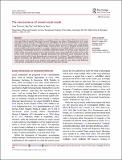The neuroscience of unmet social needs
Author(s)
Tomova, Livia; Tye, Kay; Saxe, Rebecca
DownloadAccepted version (1.025Mb)
Open Access Policy
Open Access Policy
Creative Commons Attribution-Noncommercial-Share Alike
Terms of use
Metadata
Show full item recordAbstract
© 2019, © 2019 Informa UK Limited, trading as Taylor & Francis Group. John Cacioppo has compared loneliness to hunger or thirst in that it signals that one needs to act and repair what is lacking. This paper reviews Cacioppo’s and others’ contributions to our understanding of neural mechanisms underlying social motivation in humans and in other social species. We focus particularly on the dopaminergic reward system and try to integrate evidence from animal models and human research. In rodents, objective social isolation leads to increased social motivation, mediated by the brains’ mesolimbic dopamine system. In humans, social rejection can lead to either increased or decreased social motivation, and is associated with activity in the insular cortex; while chronic loneliness is typically associated with decreased social motivation but has been associated with altered dopaminergic responses in the striatum. This mixed pattern of cross-species similarities and differences may arise from the substantially different methods used to study unmet social needs across species, and suggests the need for more direct and deliberate cross-species comparative research in this critically important domain.
Date issued
2019Department
Massachusetts Institute of Technology. Department of Brain and Cognitive SciencesJournal
Social Neuroscience
Publisher
Informa UK Limited
Citation
Tomova, Livia, Tye, Kay and Saxe, Rebecca. 2019. "The neuroscience of unmet social needs." Social Neuroscience, 16 (3).
Version: Author's final manuscript